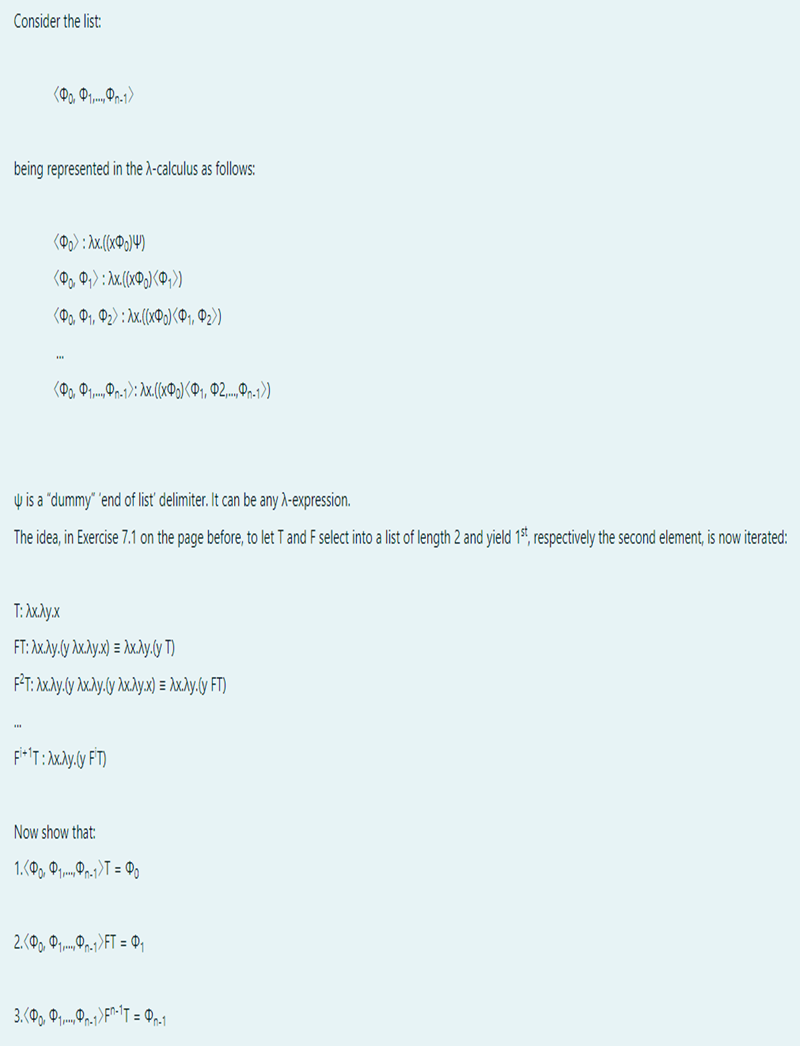Question
Please solve this with clarification No coding is needed Consider the list: (Po, 1.n-1) being represented in the -calculus as follows: (Po): x.((x0)4) (Do, 0):

Please solve this with clarification
No coding is needed
Consider the list: (Po, 1.n-1) being represented in the -calculus as follows: (Po): x.((x0)4) (Do, 0): x.((x)()) (Po, P, P): x.((x0) 0, 02)) (Po, P1, Pn-1): Ax.((x0) 0, 02, 0.1)) is a "dummy" 'end of list' delimiter. It can be any -expression. The idea, in Exercise 7.1 on the page before, to let T and F select into a list of length 2 and yield 1st, respectively the second element, is now iterated: T:Ax.ay.x FT: x.Ay.(y x.Ay.x) = x.Ay.(yT) FT: Ax.Ay.(y Ax.Ay.(y x.Ay.x) = x.Ay.(y FT) Fi+T: Ax.Ay.(y FT) Now show that: 1.00, 1-1 T = Po 2.00, 1-1)FT = 3.00 1-1 F-1 = -1
Step by Step Solution
3.39 Rating (152 Votes )
There are 3 Steps involved in it
Step: 1
To solve this problem we will apply the definitions and lambda calculus expressions provided in the ...
Get Instant Access to Expert-Tailored Solutions
See step-by-step solutions with expert insights and AI powered tools for academic success
Step: 2

Step: 3

Ace Your Homework with AI
Get the answers you need in no time with our AI-driven, step-by-step assistance
Get StartedRecommended Textbook for
Modern Control Systems
Authors: Richard C. Dorf, Robert H. Bishop
12th edition
136024580, 978-0136024583
Students also viewed these Accounting questions
Question
Answered: 1 week ago
Question
Answered: 1 week ago
Question
Answered: 1 week ago
Question
Answered: 1 week ago
Question
Answered: 1 week ago
Question
Answered: 1 week ago
Question
Answered: 1 week ago
Question
Answered: 1 week ago
Question
Answered: 1 week ago
Question
Answered: 1 week ago
Question
Answered: 1 week ago
Question
Answered: 1 week ago
Question
Answered: 1 week ago
Question
Answered: 1 week ago
Question
Answered: 1 week ago
Question
Answered: 1 week ago
Question
Answered: 1 week ago
Question
Answered: 1 week ago
Question
Answered: 1 week ago
Question
Answered: 1 week ago
Question
Answered: 1 week ago
Question
Answered: 1 week ago
Question
Answered: 1 week ago
Question
Answered: 1 week ago
View Answer in SolutionInn App



